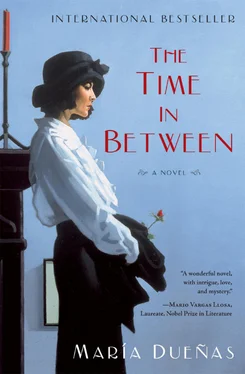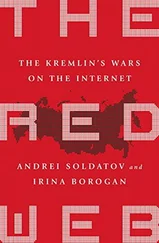It wasn’t easy to secure control over Morocco, even though the area allocated by the Treaty of Algeciras was small, the local population scant, and the land harsh and poor. It came at the cost of rebuffs and internal revolts in Spain, and thousands of Spanish and African deaths in the bloody madness of the brutal Rif War. They did manage it, however: they took control and almost twenty-five years after the official establishment of the Protectorate, with any internal resistance now having yielded, there my compatriots still were, with their capital firmly established and continuing to grow. Military men of every rank; civil servants from the postal service, customs, and public works; auditors, bank employees, businessmen and midwives, schoolteachers and nuns, bootblacks, barmen. Whole families who attracted other families in search of good salaries and a future there for the making, living alongside other cultures and religions. And me among them, just one person more. In exchange for its enforced presence over a quarter of a century, Spain had offered Morocco technical advances, developments in sanitation and infrastructure, the first steps toward a moderate improvement in agricultural yields, a school of the arts, and support for traditional crafts. And the native population obtained additional benefits as a result of satisfying the demands of the colonizers: electrification, better drinking water, schools and academies, businesses, public transport, dispensaries, and hospitals; a train linking Tetouan and Ceuta, as well as the one that still took passengers to the Río Martín beach. Spain had in material terms benefited very little from Morocco: there were barely any resources to be exploited. In human terms, however, they had obtained something important for one of the two sides in their civil strife: thousands of soldiers from the local Moroccan forces who were now fighting like wild beasts on the other side of the Strait for the distant cause of the rebel army under Franco.
Apart from learning about these matters and more besides, I enjoyed other things from Félix: company, friendship, and ideas for my business. Some of them turned out to be excellent and others altogether eccentric, but at least they gave us two solitary souls something to laugh about at the end of the day. He never managed to persuade me to transform my workshop into a studio for experimenting in surrealism in which the hats would be shaped like shoes and telephones. Nor did he get me to use sea snails for the beading or bits of esparto grass on the belts, or convince me that I should refuse to take any client lacking in glamour. I did pay attention to him on other matters, however.
Following his recommendation, for example, I changed the way I spoke. I eliminated any slang and all colloquial expressions from my speech and created a new manner to allow me a greater air of sophistication. I started using certain French words and phrases that I’d heard repeatedly in Tangiers and had picked up from nearby conversations in which I’d almost never participated or from unexpected meetings with people with whom I’d never exchanged more than three lines. It was only a handful of expressions, just half a dozen of them, but he helped me to polish up my pronunciation and calculate just the right moments to use them. They were all aimed at my clients, those now and those to come. I’d ask permission to fix pins with a vous permettez? , finalize things with voilà tout , and praise results with a très chic . I’d talk of maisons de haute couture whose owners one might have assumed had once been my friends, and of gens du monde whom I had perhaps met in my supposed wanderings here and there. Whenever I proposed a style, pattern, or accessory, I’d hang from it the verbal tag à la française ; all ladies were addressed as Madame . To highlight the patriotic dimension of the moment, we decided that whenever I had Spanish clients I would make appropriate reference to people and places I’d known in the old days when I’d been hobnobbing around the best houses in Madrid. I’d drop names and titles as easily as one might drop a handkerchief: lightly, without clamor or ostentation. That such-and-such a suit was inspired by the one I’d made a couple of years before for my friend the Marquise of Puga to debut at the Puerta de Hierro polo festival; how such-and-such a fabric was identical to the one that the eldest daughter of the Count and Countess of Encina used for her coming-out party in their palace on the Calle Velázquez.
It was also at Félix’s suggestion that I ordered a box of ivory-white cards from La Papelera Africana bearing the name and address of the business and had a gilt plaque made for the door, inscribed in ornate script: Chez Sirah—Grand Couturier. Couturier, he said, was what the best French fashion houses called themselves in those days. That final h was his touch, too, to give the workshop a more international flavor, he said. I played along with him—and why not? After all, I wasn’t hurting anyone with that little folie de grandeur . I heeded his advice on this matter and on a thousand other details, thanks to which I wasn’t just able to make my way into the future more securely, but I also managed—drumroll, please—to pull a past out of my top hat, too. I didn’t have to try too hard: with three or four poses, a handful of careful brushstrokes, and a few recommendations from my own personal Pygmalion, my small clientele set me up with a whole life in just a couple of months.
To the little colony of exclusive ladies who made up my clientele within that expatriate universe, I became a young haute couture dressmaker, daughter of a ruined millionaire, betrothed to an incredibly handsome aristocrat—both a seducer and an adventurer. It was also supposed that we had lived in several countries and found ourselves obliged by the political instability to shut up our homes and businesses in Madrid. At that moment my betrothed was off managing some prosperous firms in Argentina while I awaited his return in the capital of the Protectorate because I had been advised of the benefits of that climate for my delicate health. As my life had always been so active, so full of bustle, and so worldly, I felt incapable of just sitting around watching the time go by without devoting myself to some activity or other, and so I had decided to open a small atelier in Tetouan. Just for my own amusement, basically. Which explained why I didn’t charge astronomical prices, nor turn down any kind of commission.
I never denied a single iota of the image that had been constructed for me thanks to the picturesque suggestions of my friend Félix. Nor did I add to it. I just left it all hanging in the air, feeding the mystique and making myself less defined, more indistinct: a superb hook for bringing out people’s baser instincts and catching new clients. If only the other dressmaking girls from Doña Manuela’s workshop could have seen me then. Or the women who lived next door to us on the Plaza de la Paja, or my mother. My mother. I tried to think of her as little as possible, but her memory was constantly assailing me. I knew she was strong and determined; I realized that she would know how to get through the hard times. But all the same, how I yearned to hear from her, to learn how she was managing to get on day to day, how she was coping without any company or income. I so wanted to let her know I was well, alone again, and that I’d gone back to sewing. I kept myself informed by listening to the wireless, and every morning Jamila would go to the Alcaraz store to buy La Gaceta de África . A Second Triumphant Year under the Aegis of Franco, read the headlines. Even though all the news came to us sifted through the filter of the Nationalist side, I kept more or less up to date with the situation in Madrid and the Resistance. For all that, it was still proving impossible to get any direct word from my mother. How I missed her, how much I would have given to share everything in that strange and luminous city with her, to have set up the workshop together, to go back to eating her stews and hearing her pronouncements, always so sure. But Dolores wasn’t there and I was. Surrounded by strangers, unable to go anywhere, struggling to survive as I made up a fraudulent persona that I could step into each morning, I fought to ensure that no one discovered that an unscrupulous con man had battered my soul and a pile of pistols had enabled me to set up my business, thanks to which I had enough to feed myself each day.
Читать дальше












